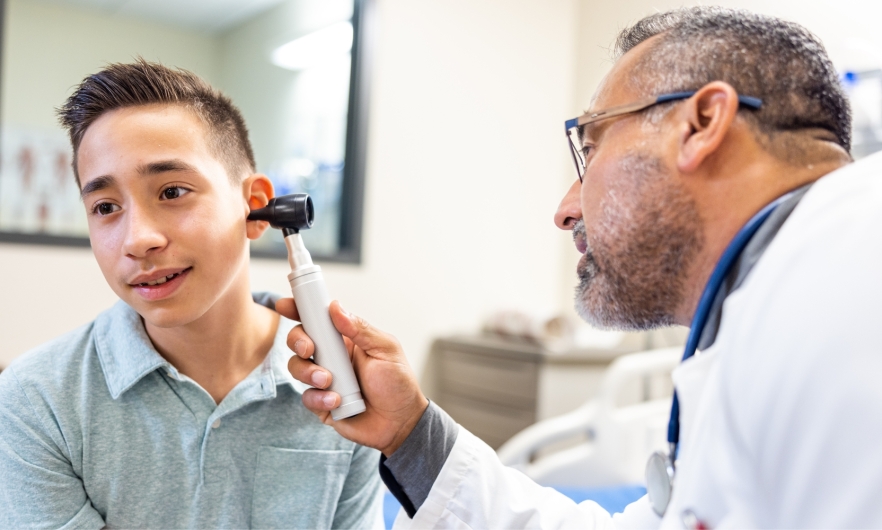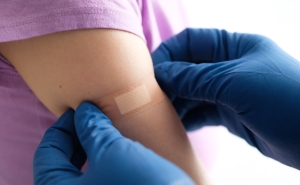Don’t Forget About the Boys
Boys and male teens need more attention from the health care system, especially when it comes to sexual health and family planning issues.

At the Center for Adolescent/Young Adult Health at Johns Hopkins’ Harriet Lane Clinic, pediatrician Arik Marcell often heard complaints from his young male patients about the free condom brands provided at school or in the community. The discussions gave him an idea.
“I created the equivalent of a free condom store in my clinic, really a large closet that they can walk in and see all the different kinds of options,” says Marcell, MD, MPH ’94, associate professor of Pediatrics at the School of Medicine with a joint appointment in Population, Family and Reproductive Health. “They come in different sizes and materials, and we’ll just say, ‘Fill a paper bag’ that they can take home. Then I challenge them, try and test them out like you would anything, and find something that works best for you.”
An expert in the health of adolescent males, Marcell has a particular interest in improving their reproductive and sexual health care, services that are routinely overlooked in primary care well visits for this group.
While primary care for adolescent girls is likely to include information about contraception and reproductive and sexual health—often when they have their first period—Marcell says the same isn’t true for male adolescents.
Here, Marcell discusses the reasons behind health care gender disparities for young males, the adverse consequences, and possibilities for narrowing the gap.
Why are adolescent males underserved when it comes to health care?
What’s interesting is that it’s a flip. In the first couple of years of life, boys tend to have greater morbidity and mortality than girls. They tend to be a little bit sicker through the childhood period. But I think once they hit school age, as long as boys appear healthy, often parents just deem them to be healthy. And starting in the pubertal period, there aren’t the same touch points that are triggers for girls to be brought in for care. Then, of those boys who do make it in, providers may not necessarily provide them what’s recommended around family planning and sexual health care.
Using one of the few datasets that follow adolescents’ well-visit attendance from ages 5 through 17, we showed the majority of adolescents attended well visits over this period. However, over one-third of adolescents became disengaged after the age 5 visit, especially boys, with three-quarters of this group becoming persistently disengaged, which is very concerning. Even in the more recent birth cohorts, those born in the last 10 to 15 years, still about a quarter of boys became disengaged after the age 5 well visit.
What information are they missing out on when these visits don’t take place?
It’s twofold. It’s very clear that preventive or well visits can help prevent or delay the start of risk behaviors—or behaviors that we might deem as risky—during adolescence, as well as prevent adult onset behaviors and related morbidity and mortality connected to cardiovascular disease, smoking, substance use, etc.
These visits are opportunities to address sexual behavior risks—the majority of STI cases occur between 15- and 24-year-olds—and other issues like substance use, smoking, mental health, nutrition and physical activity, preventable accidents, including driving and other safety issues, many of which affect males more than females. Missed well visits are lost opportunities to deliver preventive care to young males.
What can be done to connect more male adolescents with health providers?
We need to consider change at multiple levels. First, cultural gender scripts for males—“be physically tough, don’t show emotions, and don’t ask for help”—may not necessarily align with taking care of your health. We can make great strides by reframing these scripts and promoting that there are multiple ways to be male that can include taking care of oneself.
Next, health systems that are designed to support maternal and child health have not adequately considered how to support male adolescent health, especially during transition from childhood through adolescence to adulthood. We need to have innovative, funded approaches to better support structures that involve young males. We still do not have a federal Office of Men’s Health, as exists in other countries. Australia’s national men’s health strategy, for example, has developed policies and programs that promote boys’ and men’s health across the lifespan.
Also, in the U.S., at the provider level, we do not have a comparable organization like the American College of Obstetricians and Gynecologists that focuses on men across the lifespan. A long time ago, ACOG created a female adolescent toolkit that really helped to cement core services for female adolescents focused on reproductive and sexual health. There’s nothing out there that has done the equivalent easily for male adolescents.
Finally, providers themselves can do more to educate families and male adolescents about how they can be a source for reproductive and sexual health. Many male adolescents do not know how a clinician can help them, and many providers are not familiar with guidance from the American Academy of Pediatrics and the CDC about what sexual health and family planning services to provide to male adolescents.
I understand you’re working on a project to change that.
We’re developing a pre-doctor-visit app with NIH funding, that we’ll be trialing next year, for young males ages 12 to 21 to learn about sexual health and family planning. We hope to demonstrate behavior change for condom use and health care, and to use the tool to prime the clinician who will be seeing them in delivering quality family planning and sexual health care.
Before a visit, a young male will be able to use the app to learn about condoms and preventing STIs and HIV, including the use of PrEP. Then based on his answers to questions, the provider will get a summary report of health needs and tailored guidance about services to provide. The tool will also have information for young males to learn about topics like sexual function, consent, and how to have conversations about sexual health with their doctor.
You’re also leading a study involving young men headed for fatherhood, text4FATHER.
With developmental funding from a Hopkins Discovery Award in 2016, we were able to demonstrate that fathers over 18 in Baltimore—with young children and lower income and education levels—expressed an interest in having additional knowledge and skills to support their pregnant partner and infant after birth. With input from fatherhood experts across the country, we developed a text-messaging program for expectant fathers to learn more about pregnancy, the developing baby, development after birth, cooperative parenting and, specifically, how to become more involved with their baby.
We’re now evaluating whether texting fathers twice a week with supportive content when their partner is mid-pregnancy—using the 20-week ultrasound as an opportunity to connect with them—and continuing to text after the birth can improve their confidence and behaviors in taking care of their infant. The concept is to engage the father—who otherwise has no clinical or public health touch points to learn about the pregnancy process—as an important part of the family triad. Fatherhood can also be an opportunity for men to make positive health behavior changes. A large body of literature has demonstrated the important role that fathers can play in infant development and [the value of] engaging fathers as early as possible during pregnancy, yet we’ve seen little to no translation of this evidence to practice on a larger scale.
The hope is that this work will show that we can improve fathers’ knowledge, self-efficacy, and behavioral involvement about infant care and disseminate it on a large scale. Our preliminary findings are very exciting, and we are eager to share them once we’ve completed the study.
Jackie Powder is the assistant editor of Hopkins Bloomberg Public Health magazine.
RELATED:





